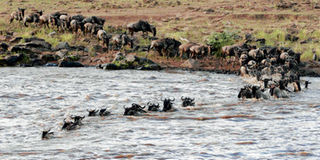Maasai Mara has lost half its animals

A part of a herd of some 1.5 million wildebeests crosses the Mara River in the Maasai Mara Game Reserve during their annual migration, one of the main tourist attractions in Kenya, The reserve has lost a large percentage of its animals since the 1970s. Photo/FILE
The Maasai Mara has lost almost 60 per cent of its large animals, including lions, elephants, buffaloes, leopards and rhinos, according to the United Nations Environmental Programme.
A continent-wide study, released last week found big mammal populations inside national parks, including Kenya’s Maasai Mara and Tanzania’s Serengeti to have declined by an average of 59 per cent between 1970 and 2005.
This confirms an earlier count carried out by Dr Joseph Ogutu, formerly a statistical ecologist at the Nairobi based International Livestock Research Institute (ILRI) which claimed losses at the park were as high as 95 per cent for giraffes, 80 per cent for warthogs, 76 per cent for hartebeest and 67 per cent for impala..
The ILRI report had then met instant and strong opposition from conservationists who claimed it had got it all wrong and was exaggerated. The Mara Conservancy claimed the report released last year had failed to specify whether the findings were drawn only from the reserve or the larger Mara ecosystem.
The conservancy claimed there had been a phenomenal increase of wildlife outside the park in the last 60 years. But a statement from the London Zoological Society on Monday contradicts the Conservancy’s position on wildlife increases. “Although the results indicate that African national parks have generally failed to maintain their populations of large mammals, the situation outside the parks is almost undoubtedly worse. Many species like rhino are practically extinct outside national parks,” says the statement.
The Africa-wide study, carried out jointly by the London Zoological Society and published in Biological Conservation indicates a great variation by region with animal populations increasing in southern Africa, declining by more than half in East Africa and having 85 per cent declines in West Africa.
The increase of wildlife in southern Africa, says the study, offers hope that with more resources and determination, the situation can be reversed in East Africa. “The situation we documented paints a bleak picture and requires urgent and decisive action if we want to save this treasure,” said Dr Ogutu, the lead author of the earlier study and who has since left ILRI.
The team behind the survey says the likeliest explanation for the decline is over-hunting and changing habitats, both of which are driven by fast-expanding human populations. On Thursday scientists at the Kenya Wildlife Service were in agreement that the country has not only lost hoofed animals but also a huge number of carnivores including lions, cheetahs, hyenas and wild dogs.
A senior KWS scientist Charles Musyoki told a workshop in Nairobi that the rapid decline of wild cats is caused by prolonged drought and limited roaming areas. He said human encroachment on parks was a major factor in the diminishing number of lions, cheetahs, hyenas and wild dogs.
The earlier study had monitored seven-hoofed species, ungulates, monthly between 1989 and 2003 in the 1,500-square kilometre Maasai Mara National Reserve and concluded that six species — giraffes, hartebeest, impala, warthogs, topis and waterbuck — had declined markedly.
The ILRI said the main reason for the decline is the encroachment of wildlife grazing areas by the local Maasai. “Some traditional farming cultures to the west and southwest of the Mara continue to hunt wildlife inside the reserve for food and profit,” said Dr Ogutu. The team also found an increase of permanent settlements by the Maasai, who for years have been nomadic.
In just one of the ranches adjacent to the reserve — the Koyiaki Ranch — the number of bomas surged from 44 in 1950 to 368 in 2003, while the number of huts increased from 44 to 2,735. The study warned that retaliatory killings of wildlife that break down fences, damage crops, degrade water supplies or threaten livestock and humans is “common and increasing” in the ranch lands.
The various forces threatening wildlife could have grave consequences for protecting game because, given the seasonal movements of animals in and out of the reserve, most of the wildlife in the region regularly graze outside the protected reserve,” said Dr Ogutu.




